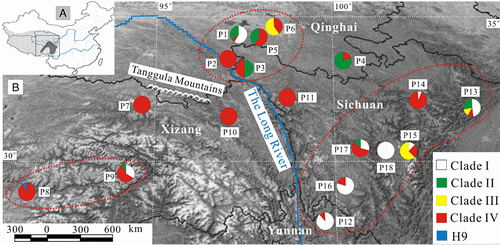In the present study, we used two maternally inherited plastid DNA intergenic spacers, rpl20-rps12 and trnS-trnG, and the biparentally inherited nuclear ribosomal internal transcribed spacer (ITS) region to explore genetic variation and phylogeographical history of Rhodiola alsia, a herb endemic to the Qinghai-Tibetan Plateau (QTP). Based on range-wide sampling (18 populations and 227 individuals), we detected 45 plastid DNA haplotypes and 19 ITS sequence types. Only three plastid DNA haplotypes were widespread; most haplotypes were restricted to single sites or to neighbouring populations. Analysis of molecular variance revealed that most of the genetic variance was found within populations (51.24%) but that populations were also distinct (FST = 0.48759).
We found three areas with relatively high plastid DNA diversity and these could further be recognized as potentially isolated divergence centres based on the ITS sequence type distribution. These represent three potentially isolated glacial refugia for R. alsia: one of them has long been recognized as an important refugium on the south-eastern edge of the QTP, whereas the others are new and located in the north and south of the Tanggula Mountains on the plateau platform. Divergence time estimates based on ITS suggest that the main lineages of R. alsia diverged from each other 0.35–0.87 Mya, indicating that climatic oscillations during the Pleistocene may have been an important driver of intraspecific divergence in R. alsia. Rhodiola alsia probably experienced a phylogeographical history of retreat to isolated glacial refugia during Quaternary glaciations that led to different degrees of allopatric intraspecific divergence.

Figure 1. A, map of China, indicating the Qinghai-Titetan Plateau (lightly shaded) and
the distribution range of Rhodiola alsia (darkly shaded).
B, map showing the sampled populations of R. alsia and the distribution of four plastid DNA haplotype clades (I–IV) and H9 as identified by the maximum parsinomy analysis in
Fig. 2. Areas indicated by red broken lines represent three potentially glacial refugia for R. alsia.
Additional Information:
1 Author Information:QINGBO GAO, DEJUN ZHANG, YIZHONG DUAN, FAQI ZHANG, YINHU LI, PENGCHENG FU and SHILONG CHEN
Correspondence: E-mail: slchen@nwipb.cas.cn
2 Publication History:
Article first published online: 24 NOV 2011
Received 27 July 2010; revised 5 June 2011; accepted for publication 24 September 2011.
